
 Rapid Design through Virtual and Physical
Prototyping
Rapid Design through Virtual and Physical
Prototyping
 Rapid Design through Virtual and Physical
Prototyping
Rapid Design through Virtual and Physical
Prototyping
![]()
Procedure for Making a Silicone Molds
Before starting the process of making a silicone rubber mold, you must first gather all the required tools, materials, and safety equipment. It is importance to have everything ready and handy, since the working life of polymers, i.e. the time they can flow, is not very long.

The required tools for the process are a knife, a scalpel, a pair of cutting pliers, a file, a screw driver, and a spatula for mixing.

To set our master in position, you will need a base plate, adjustable mold wall, thin wire, the master itself, and spacers.
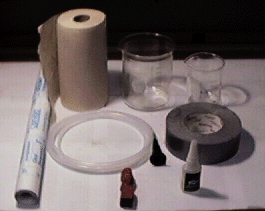
Additional equipment includes contact paper, paper towels, 2 mixing beakers, a tube with a funnel, masking tape, plaster, and super glue.

The silicone rubber material comes in two components that mix by a volume ratio of 1:1. Propanol alcohol is used to clean the polymers before they cure. The casting material used to make parts also mixes on a volume basis of 1:1. Finally, you need the release agent.

Since the polymers are toxic, you must wear a respirator mask during polymer handling. A lab coat, latex gloves and goggles are necessary to prevent any body contact with the irritant polymers.

Before starting the silicone rubber mold, the surface of the master that you want to replicate must be examined carefully for imperfections. This is a critical step because the silicone rubber mold and its polyurethane parts will replicate exactly the surface of the original master. To ensure a high-quality surface on the polyurethane cast part, you can use a smooth finish with #400 grit emery cloth. In the example below, the master was very smooth and no polishing was required.
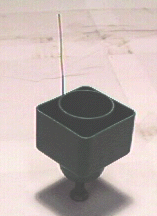
Elevate the master from the ground by attaching a support to it. The purpose of raising the master above the ground is to allow the silicone to form a mold wall that is at least 1/2 inch thick on the bottom. If the wall is thinner then 1/2 inch in any location, the mold might be weak enough to tear during de-molding. We elevated our master by gluing a screw with super glue as indicated. Since polymer from which new parts will be cast will be entering the silicone mold from the bottom, air in the mold must have a way to exit. This can be achieved by super gluing thin wires on the top most edges of the master, i.e. the edges where air will be trapped. We cut relatively thin wire with cutting pliers and sanded one edge flat to increase the wire bonding area.

Before securing the master to the plate (the bottom of the mold), the plate treated so the mold material doesn't stick to it. We used contact paper to avoid the use of wax pastes. We secured the master to the plate using super glue to glue the screw to the bottom plate surface. In some instances, modeling clay can be used to secure the master to the plate instead. If the master is not secured to the plate, separation can occur when pouring the silicone rubber into and around the master.

Next, apply a coat of wax release agent to all master surfaces. This will facilitate separation of the master from the completed silicone rubber mold.

Place the adjustable mold wall around the master keeping in mind that it should be no closer then 1/2 inch, so that the silicone mold wall will be thick enough. Use modeling clay to fill any voids where silicone rubber might leak. Make sure you are careful during this step. If the silicone leaks, it is very hard to stop it since no material wetted with silicone can stick and stop a leakage.
Now you are ready to mix the silicone rubber materials and pour them into the mold.
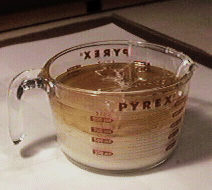
Calculate approximately the volume of the silicon rubber material required to fill your mold. Prepare about 20% more to account for loses. Since the silicone material mixes on 1:1 ratio per volume, one half the required material should come from each component. Use disposable containers with a volume scale to mix the material in.

Make sure the material is thoroughly mixed keeping in mind that mixing should be done gently so that air is not introduced into the materia. Minimizing bubbles is important, because we will skip the degassing process which requires commerical equipment. If you can see air bubbles on the surface, use the end of a screw driver to poke them open. Keep in mind that the working life of the silicone rubber material is 15-20 minutes, which means once the components are in touch with each other, you have at most 20 minutes to mix and pour them.
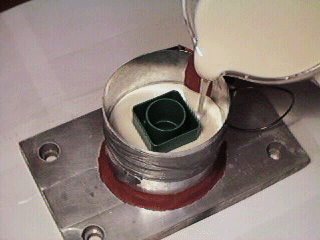
Pour the silicon slowly so that no air pockets are left around the master walls. The mold arrangement can be tilted at a slight angle if a large horizontal surface is present. Tilting will decrease the chances of getting air pockets trapped underneath large horizontal surfaces.
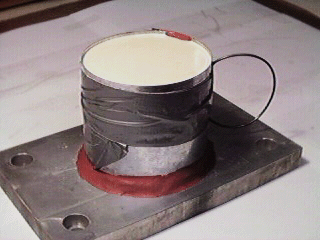
Once the mold arrangement is filled, let the it cure for 24 hours before taking it apart.

To assure that the silicone cans remain properly sealed for future use, spray some release agent around the cover of the Prepolymer silicone component. If the release agent isn't used, this components tends to form a crust which decreases the cover sealing tightness with time.

Once the curing time has elapsed, de-mold the arrangement. Since we made a one piece mold (one pouring only), we cut the final silicone rubber piece into two halves. (Cutting could be avoided by making a two part mold.)
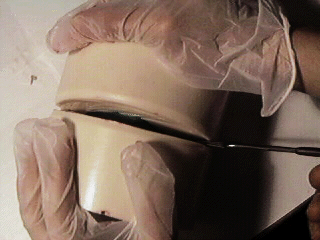
Use the scalpel to slice the mold open. Several scalpel passes might be necessary before the master is reached. Do not worry about the smoothness of the cut. On the contrary, a non-uniform cut reduces the chance of positioning the two mold parts incorrectly. However, do not exaggerate. A horizontal parting line on a vertical master surface gives the best casting results. This is a two person job, where one person "pulls" the mold apart so that the scalpel travels more easily during cutting, while the other person cuts.
Keep in mind that this is the most dangerous step in the process of making silicone molding.
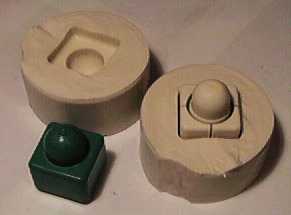
Once the cutting is complete, gently pull the two mold parts apart. Then, pull the master out of the half mold. Silicone rubber is flexible and can withstand a lot of stretching. However, care should be taken not to tear the rubber material apart
Now that you have a mold, you can cast parts.

Apply a coat of release agent to the silicone mold to prevent the casting polymer from sticking to the silicone rubber.

Since the best casting results are obtained by pouring the polymer from the bottom up, we used the supporting screw hole as the polymer intake cavity.
Pouring is done by placing a tube into the silicone mold and a funnel on the other end of the tube. To prevent leakage, seal the tube insertion hole with plaster. Then, position the mold onto a stand so that the tube can bend smoothly upward. Secure the two mold pieces so that they won't come apart when the polymer is poured in. We used tape to do so.
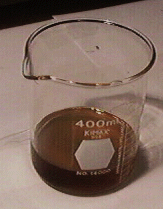
Mix the appropriate 1:1 volume ratio of the polymer necessary for replicating the master by accounting for the master's volume as well as loses that will occur in the tube and container walls. Once again, a disposable beaker is best, since the cleaning process can be difficult. The tube cannot be cleaned. If funnels are scarce or expensive, they can be cleaned with propanol alcohol before the polymer cures.

Once the casting polymer has been mixed, keep the funnel above the mold's top surface and slowly pour the polymer in. Remember to adjust your mixing and pouring time so that the polymer doesn't cure before it has fully penetrated into the mold.
tprodan@andrew.cmu.edu